
Another neat batch of titles this week, mostly from the higher-end producers of animated fare (Terrytoons and Columbia miss the cut). Among notable directors’ work featured are classics by Frank Tashlin, James (Shamus) Culhane, the young Jack Hannah, Dick Lundy, Chuck Jones, and of course, the master Tex Avery. We’ll know by time of posting how my local Los Angeles fared the first strike of a tropical storm threatened since 1939, from which I hope a viewing of these shorts may be a welcome respite.
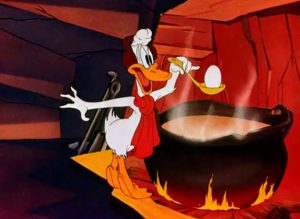 Booby Hatched (Warner, 10/14/44, Frank Tashlin, dir.) – Our scene opens on a barn in the middle of winter. As cold breezes and wafting snow blow through a cracked window pane, a Mama Duck inside the barn trembles with cold, her teeth (fine dentures these ducks have in their bill) chattering. She stands up from her nest to reveal the eggs she is trying to hatch, which also tremble and instantly turn blue. Mama rushes the eggs to a candle to see what’s going on inside. The first egg reveals silhouette of a duckling trying to keep warm with a miniature pot-bellied stove inside his shell. Inside the next, a duckling sneezes. Mama blesses him, “Gesundheit!”. and he responds, “Thank you.” The duckling in the third egg performs a classic figure skating routine. And the fourth is on skis and performs a ski jump, but makes a crash landing, leaving cracks in his eggshell. Mama returns to the nest and aligns the eggs in a neat triangle with a pool rack. But sitting on them does nothing, as a nest thermometer reads, “Cold as a brass monkey”. She decides extreme measures are in order. Turning up the flame of a kerosene lamp, she places her rear end as close to the flame as she dares. Sweating and removing her scarf, she succeeds in making her tail a glowing red hot. Returning to the nest, she is about to set her fiery bottom upon her expected brood – when they all pop out of their eggs simultaneously, yelling: “DON’T DO IT!!! We’ll come out.”
Booby Hatched (Warner, 10/14/44, Frank Tashlin, dir.) – Our scene opens on a barn in the middle of winter. As cold breezes and wafting snow blow through a cracked window pane, a Mama Duck inside the barn trembles with cold, her teeth (fine dentures these ducks have in their bill) chattering. She stands up from her nest to reveal the eggs she is trying to hatch, which also tremble and instantly turn blue. Mama rushes the eggs to a candle to see what’s going on inside. The first egg reveals silhouette of a duckling trying to keep warm with a miniature pot-bellied stove inside his shell. Inside the next, a duckling sneezes. Mama blesses him, “Gesundheit!”. and he responds, “Thank you.” The duckling in the third egg performs a classic figure skating routine. And the fourth is on skis and performs a ski jump, but makes a crash landing, leaving cracks in his eggshell. Mama returns to the nest and aligns the eggs in a neat triangle with a pool rack. But sitting on them does nothing, as a nest thermometer reads, “Cold as a brass monkey”. She decides extreme measures are in order. Turning up the flame of a kerosene lamp, she places her rear end as close to the flame as she dares. Sweating and removing her scarf, she succeeds in making her tail a glowing red hot. Returning to the nest, she is about to set her fiery bottom upon her expected brood – when they all pop out of their eggs simultaneously, yelling: “DON’T DO IT!!! We’ll come out.”
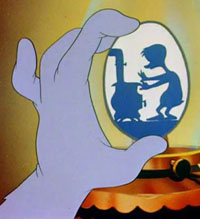 Did I say all? Well, not quite. As Mom takes her ducklings out for their first stroll, a leftover is discovered by the camera in the nest – a half-hatched duckling, with only its feet sticking out of the shell. “Hey, who turned off the heat?” says a muffled voice from inside. Blindly, he tries to follow Mama, who has reached the pond and dived in with the rest of her offspring. One touch of his foot in the icy water, and the egg-bound duckling races back to the barn and the heat of the kerosene lamp. But the lamp goes out. “Darn this fuel oil shortage”, the duckling complains. He determines to seek out someone to sit on him – “with a nice warm – – – disposition.” Back at the pond, Mama takes inventory of her youngsters by name. Four names are of interest: “Franklin” and “Eleanor” (names of the current President and first lady), “Winston” (Churchill, no doubt), and “Leon” (free plug for Mr. Schlesinger). But when she reaches the unlikely name of “Robespierre”, there is no responding quack. Counting on her fingers to make sure her math isn’t in error for attendance roll, Mama goes into a complete panic, and with an endless stream of screams, “ROBESPIERRE!!!!!”, scours the entire barnyard and vicinity in superspeed motion for any sign of her wayward son. A trail of small webbed footprints is finally discovered leading into the deep woods.
Did I say all? Well, not quite. As Mom takes her ducklings out for their first stroll, a leftover is discovered by the camera in the nest – a half-hatched duckling, with only its feet sticking out of the shell. “Hey, who turned off the heat?” says a muffled voice from inside. Blindly, he tries to follow Mama, who has reached the pond and dived in with the rest of her offspring. One touch of his foot in the icy water, and the egg-bound duckling races back to the barn and the heat of the kerosene lamp. But the lamp goes out. “Darn this fuel oil shortage”, the duckling complains. He determines to seek out someone to sit on him – “with a nice warm – – – disposition.” Back at the pond, Mama takes inventory of her youngsters by name. Four names are of interest: “Franklin” and “Eleanor” (names of the current President and first lady), “Winston” (Churchill, no doubt), and “Leon” (free plug for Mr. Schlesinger). But when she reaches the unlikely name of “Robespierre”, there is no responding quack. Counting on her fingers to make sure her math isn’t in error for attendance roll, Mama goes into a complete panic, and with an endless stream of screams, “ROBESPIERRE!!!!!”, scours the entire barnyard and vicinity in superspeed motion for any sign of her wayward son. A trail of small webbed footprints is finally discovered leading into the deep woods.
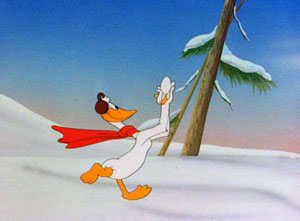 Ahead, we follow Robespierre trudging though a blizzard. “This is the saddest part of the picture, folks”, he asides to us. Behind a tree, a wolf appears, holding up a sign with his own comment: “And he ain’t whistling Dixie”. The duckling wanders into a cave, encountering a sleeping bear. “Yippee, it’s Mama. With a fur coat yet!” The duck darts underneath the bear’s bottom. In ultra-low key read reminiscent of many a Tex Avery cartoon, the bear sleepily looks under his leg, and unemotionally remarks, “So I laid an egg.” The wolf appears, and takes care of the situation by planting a stick of dynamite under the bear, blasting him to the ceiling while the wolf steals the egg away. Landing in a heap back on the floor of the cave, the bear is still hardly phased, merely remarking, “Dreams like this worry me, y’know?” The remainder of the film becomes a game of chase and keep-away, as Mama appears, gives the wolf a series of Moe Howard-style eye pokes, and tries to save junior, but almost gets faked out by the wolf, who substitutes a doorknob in place of her egg. One more eyepoke at the wolf’s door, and Mama is inside, rescuing the floating egg from the wolf’s stewpot. But Robespierre finally pops out of the shell, complaining, “Aw, Maw! Just when I was getting warm!”, and hops back into the pot, using the shell as a raft to sail around in the comforting steam.
Ahead, we follow Robespierre trudging though a blizzard. “This is the saddest part of the picture, folks”, he asides to us. Behind a tree, a wolf appears, holding up a sign with his own comment: “And he ain’t whistling Dixie”. The duckling wanders into a cave, encountering a sleeping bear. “Yippee, it’s Mama. With a fur coat yet!” The duck darts underneath the bear’s bottom. In ultra-low key read reminiscent of many a Tex Avery cartoon, the bear sleepily looks under his leg, and unemotionally remarks, “So I laid an egg.” The wolf appears, and takes care of the situation by planting a stick of dynamite under the bear, blasting him to the ceiling while the wolf steals the egg away. Landing in a heap back on the floor of the cave, the bear is still hardly phased, merely remarking, “Dreams like this worry me, y’know?” The remainder of the film becomes a game of chase and keep-away, as Mama appears, gives the wolf a series of Moe Howard-style eye pokes, and tries to save junior, but almost gets faked out by the wolf, who substitutes a doorknob in place of her egg. One more eyepoke at the wolf’s door, and Mama is inside, rescuing the floating egg from the wolf’s stewpot. But Robespierre finally pops out of the shell, complaining, “Aw, Maw! Just when I was getting warm!”, and hops back into the pot, using the shell as a raft to sail around in the comforting steam.
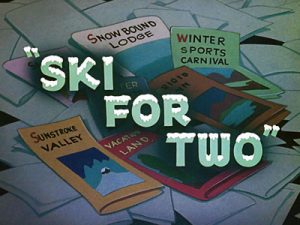 Ski for Two (Lantz/Universal, Woody Woodpecker, 11/13/44 – James Culhane, dir.) – Release schedules often seem to bear little relationship to the seasonal content of the films presented. As we’ve seen in previous installments of these articles, Halloween films have been known to show up in March or April. In other instances, definite Christmas films have been delayed until after New Years Day. Here, we have a strange one. Its snowy setting seems appropriate for a November release. It would even come to be known among home movie collectors by the seasonal retitling “Woody Plays Santa Claus”. However, its plotline clearly indicates that the month in which the story takes place is supposed to be early October. So the film, although close, is nearly a full month late. Still, in the flurry of action flashing before the audience’s eye for seven minutes, few patrons probably ever noticed.
Ski for Two (Lantz/Universal, Woody Woodpecker, 11/13/44 – James Culhane, dir.) – Release schedules often seem to bear little relationship to the seasonal content of the films presented. As we’ve seen in previous installments of these articles, Halloween films have been known to show up in March or April. In other instances, definite Christmas films have been delayed until after New Years Day. Here, we have a strange one. Its snowy setting seems appropriate for a November release. It would even come to be known among home movie collectors by the seasonal retitling “Woody Plays Santa Claus”. However, its plotline clearly indicates that the month in which the story takes place is supposed to be early October. So the film, although close, is nearly a full month late. Still, in the flurry of action flashing before the audience’s eye for seven minutes, few patrons probably ever noticed.
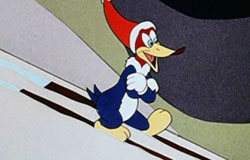 Woody is first seen on the floor of his home, planning a vacation from a room full of travel brochures. He is not as usual cast as penniless, as we discover from, among other factors, his ability to swing railroad fare. Yet, his old mooching instincts seem to still have an effect on his decisions, as the brochure that catches his eye is one from the Swiss Chard Lodge, Sunstroke Valley, Idaho, which advertises as its chief selling point, “Excellent Food”. “Food! That’s my favorite dish!, shouts Woody, who disappears into his closet, then gallops out the door carrying skis, snowshoes, skates, a sled, and a warm woolen hat. He boards a train, and falls asleep on the observation platform of the rear car. As the train progresses on, the climate changes from cold, to colder, to colder still. Snow falls thickly all around him, until the entire train car is covered over with it, and all that can be seen of Woody are his head and the protruding skis on his feet. The entire track, and the train itself, are lost from view, as only the path of the puffing smokestack remains visible above snow level. The train comes to a stop at Sunstroke Valley station, resembling a locomotive-shaped snowman. It immediately develops the shakes, and flings the snow covering off itself left and right. The last portion of the train to shake off its wintery coating is Woody’s car, with a last flip of its “tail” flinging Woody off the train altogether, and landing him upside down in a snowbank. Woody pops his head out of the snowdrift, and finds himself directly before a wooden sign, pointing the way to Swiss Chard Lodge, reading “40 miles as the crow flies – But who wants to ride with an old crow?” Woody decides he will take a “short cut”, and leaps to his feet, dashing down the slopes on his skis for a brisk cross-country journey. He performs fancy maneuvers, up and down slopes, avandoning his skis to skate across a frozen lake, then meeting up with the still-sliding skis on the opposite side, and plowing through snowbanks, all the while performing a vocal of a lively old choral work from 1926, “The Sleigh” by Richard Kountz and Ivor Tchervanow. (Woody’s vocal while singing, as with many cartoons from this period, is provided by Lee Sweetland in sped-up vocal track. He was a great voice match for Woody’s speaking voice – right down to singing Woody’s laugh.) In a POV shot that attempts to depict skiing past layers of snowdrifts without the aid of a multiplane camera (a luxury Lantz could never afford), Woody makes a final downslope run, face-first into the door of the lodge.
Woody is first seen on the floor of his home, planning a vacation from a room full of travel brochures. He is not as usual cast as penniless, as we discover from, among other factors, his ability to swing railroad fare. Yet, his old mooching instincts seem to still have an effect on his decisions, as the brochure that catches his eye is one from the Swiss Chard Lodge, Sunstroke Valley, Idaho, which advertises as its chief selling point, “Excellent Food”. “Food! That’s my favorite dish!, shouts Woody, who disappears into his closet, then gallops out the door carrying skis, snowshoes, skates, a sled, and a warm woolen hat. He boards a train, and falls asleep on the observation platform of the rear car. As the train progresses on, the climate changes from cold, to colder, to colder still. Snow falls thickly all around him, until the entire train car is covered over with it, and all that can be seen of Woody are his head and the protruding skis on his feet. The entire track, and the train itself, are lost from view, as only the path of the puffing smokestack remains visible above snow level. The train comes to a stop at Sunstroke Valley station, resembling a locomotive-shaped snowman. It immediately develops the shakes, and flings the snow covering off itself left and right. The last portion of the train to shake off its wintery coating is Woody’s car, with a last flip of its “tail” flinging Woody off the train altogether, and landing him upside down in a snowbank. Woody pops his head out of the snowdrift, and finds himself directly before a wooden sign, pointing the way to Swiss Chard Lodge, reading “40 miles as the crow flies – But who wants to ride with an old crow?” Woody decides he will take a “short cut”, and leaps to his feet, dashing down the slopes on his skis for a brisk cross-country journey. He performs fancy maneuvers, up and down slopes, avandoning his skis to skate across a frozen lake, then meeting up with the still-sliding skis on the opposite side, and plowing through snowbanks, all the while performing a vocal of a lively old choral work from 1926, “The Sleigh” by Richard Kountz and Ivor Tchervanow. (Woody’s vocal while singing, as with many cartoons from this period, is provided by Lee Sweetland in sped-up vocal track. He was a great voice match for Woody’s speaking voice – right down to singing Woody’s laugh.) In a POV shot that attempts to depict skiing past layers of snowdrifts without the aid of a multiplane camera (a luxury Lantz could never afford), Woody makes a final downslope run, face-first into the door of the lodge.
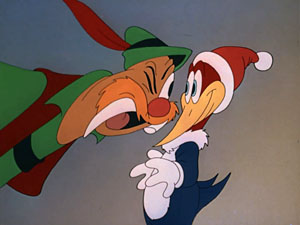 Woody peers in a window, and spots the proprietor, Wally Walrus, chowing down on a table full of choice foodstuffs, including a prominent roast ham. Camera action follows Wally’s hands in extreme close up as portion after portion is deposited in Wally’s mouth. Wally talks to himself about how good the food is. “Even if I did cook it myself, it’s wonderful.” That’s all Woody needs to know. He knocks on the door, and when it opens, exchanges the necessary formalities. “Howdy pop. Woody’s my name. What’s yours? Never mind, skip it. How ‘bout some of that excellent food?” He tries to enter, but Wally holds him back, referring to him as “impulsive”. “Impulsive? I’m repulsive”, responds Woody. Wally points out a sign indicating positively no accommodations without a reservation – the one thing Woody forgot to do. “I’ve got lots of reservations. Have some”, insists Woody, handing Wally an armful of paper stubs. They include reservations for Yankee Stadium, the Trocadero, and the Rose Bowl – but none for the lodge. A brawl ensues, as Wally throws the obnoxious bird over a hill and into a snowdrift, in which he meets a wild reindeer. Getting an idea, Woody comes up from nowhere with a sleigh and a Santa suit, puts the deer in harness, and arrives at the lodge with a large sack. Wally, seeing “Kris Kringle” coming, decorates the lodge interior with a Christmas tree and holiday decorations in the twinkling of an eye, hangs a stocking by the fireplace, and jumps into bed, pretending to be asleep. Woody comes down the chimney, but with nothing in his sack. Instead, he begins stuffing all the lodge’s food into the sack for himself. Wally decides to cheat by snatching ihis stocking from the fireplace and carrying it into the bedroom. He reaches in for his goodies, but finds only a handful of air. Scratching his head, he peers out at “Santa”, only to observe him bent over, exposing a woodpecker butt under the Santa suit. Still trying to put two and two together, his eyes finally fall on a wall calendar – for the month of October, with “only 70 shopping days till Xmas” indicated thereon. Wally’s confusion turns into rage. The boys resort to fisticuffs in a fight over the sack, throwing each other out the front door – until finally, Woody finds himself and the sack both outside. He grabs it, and reverses his cross-country skiing, finally arriving at a clearing where he feels it is safe enough to open the sack for a sampling of those goodies. As a surprise ending, all he finds inside the sack is Wally, who imitates Woody’s laugh, and ends the film shaking Woody in a stranglehold, for the iris out.
Woody peers in a window, and spots the proprietor, Wally Walrus, chowing down on a table full of choice foodstuffs, including a prominent roast ham. Camera action follows Wally’s hands in extreme close up as portion after portion is deposited in Wally’s mouth. Wally talks to himself about how good the food is. “Even if I did cook it myself, it’s wonderful.” That’s all Woody needs to know. He knocks on the door, and when it opens, exchanges the necessary formalities. “Howdy pop. Woody’s my name. What’s yours? Never mind, skip it. How ‘bout some of that excellent food?” He tries to enter, but Wally holds him back, referring to him as “impulsive”. “Impulsive? I’m repulsive”, responds Woody. Wally points out a sign indicating positively no accommodations without a reservation – the one thing Woody forgot to do. “I’ve got lots of reservations. Have some”, insists Woody, handing Wally an armful of paper stubs. They include reservations for Yankee Stadium, the Trocadero, and the Rose Bowl – but none for the lodge. A brawl ensues, as Wally throws the obnoxious bird over a hill and into a snowdrift, in which he meets a wild reindeer. Getting an idea, Woody comes up from nowhere with a sleigh and a Santa suit, puts the deer in harness, and arrives at the lodge with a large sack. Wally, seeing “Kris Kringle” coming, decorates the lodge interior with a Christmas tree and holiday decorations in the twinkling of an eye, hangs a stocking by the fireplace, and jumps into bed, pretending to be asleep. Woody comes down the chimney, but with nothing in his sack. Instead, he begins stuffing all the lodge’s food into the sack for himself. Wally decides to cheat by snatching ihis stocking from the fireplace and carrying it into the bedroom. He reaches in for his goodies, but finds only a handful of air. Scratching his head, he peers out at “Santa”, only to observe him bent over, exposing a woodpecker butt under the Santa suit. Still trying to put two and two together, his eyes finally fall on a wall calendar – for the month of October, with “only 70 shopping days till Xmas” indicated thereon. Wally’s confusion turns into rage. The boys resort to fisticuffs in a fight over the sack, throwing each other out the front door – until finally, Woody finds himself and the sack both outside. He grabs it, and reverses his cross-country skiing, finally arriving at a clearing where he feels it is safe enough to open the sack for a sampling of those goodies. As a surprise ending, all he finds inside the sack is Wally, who imitates Woody’s laugh, and ends the film shaking Woody in a stranglehold, for the iris out.
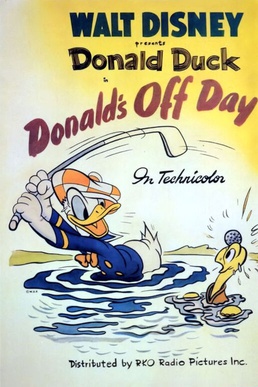 Donald’s Off Day (Disney/RKO, Donald Duck, 12/8/44 – Jack Hannah, dir.) – A cheery sunrise greets the sleeping Donald Duck in his bedroom with its glowing rays. Though warmed by them, Donald remains nodding off, until his alarm clock starts ringing – and ringing – and ringing, and runs out of spring power, finally stopping, and toppling over on its face. While the clanging alarm bell did nothing to arouse the duck, the barely-audible thump as the clock tips over awakens Donald in an instant. He is now all vim and vigor, thumping his chest like Tarzan, and rises full of energy. However, before leaving bed, he untucks from under the blanket a companion he has been sleeping with – his prized matched set of golf clubs. Donald obviously has plans for this morning. In a display of super speed, Donald zips through his morning routine. A shower, brushing of teeth, a breakfast partially prepared by using his clubs to drive eggs into a frying pan, and a quick goodbye kiss to his just-rising nephews, who are still in their nightshirts. Donald zooms to the door, anxious to reach the first tee, and struts majestically outside. No sooner does his foot touch the ground, than the sky transforms from brilliant sunshine to downpouring rain and thunder. “Oh, fooey”, moans Donald in utter dejection. He turns to drag his slumping form back into the house, when the weather performs another one-frame change of disposition, reverting back to full sunshine. Amazed and surprised, Donald spins around, and begins to resume his happy strut. With another clap of thunder, the rain returns on cue in a flash. Donald starts to get angry about these sudden shenanigans, and reverts to his fighting pose.
Donald’s Off Day (Disney/RKO, Donald Duck, 12/8/44 – Jack Hannah, dir.) – A cheery sunrise greets the sleeping Donald Duck in his bedroom with its glowing rays. Though warmed by them, Donald remains nodding off, until his alarm clock starts ringing – and ringing – and ringing, and runs out of spring power, finally stopping, and toppling over on its face. While the clanging alarm bell did nothing to arouse the duck, the barely-audible thump as the clock tips over awakens Donald in an instant. He is now all vim and vigor, thumping his chest like Tarzan, and rises full of energy. However, before leaving bed, he untucks from under the blanket a companion he has been sleeping with – his prized matched set of golf clubs. Donald obviously has plans for this morning. In a display of super speed, Donald zips through his morning routine. A shower, brushing of teeth, a breakfast partially prepared by using his clubs to drive eggs into a frying pan, and a quick goodbye kiss to his just-rising nephews, who are still in their nightshirts. Donald zooms to the door, anxious to reach the first tee, and struts majestically outside. No sooner does his foot touch the ground, than the sky transforms from brilliant sunshine to downpouring rain and thunder. “Oh, fooey”, moans Donald in utter dejection. He turns to drag his slumping form back into the house, when the weather performs another one-frame change of disposition, reverting back to full sunshine. Amazed and surprised, Donald spins around, and begins to resume his happy strut. With another clap of thunder, the rain returns on cue in a flash. Donald starts to get angry about these sudden shenanigans, and reverts to his fighting pose.
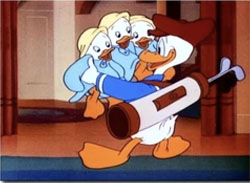 The storm responds, by shooting a jet of rain water straight into his mouth, leaving the duck coughing and sputtering. Inside the house, the nephews have taken up a game in the living room with a ride-on kiddie-car train, when they hear the front door slam violently. The furious Donald enters the shot, and vents his temper upon the kids for no good reason. “Get up to your room. Scram!” he orders. Though the kids see no justification in this behavior, they know better than to cross their uncle when he’s in one of these moods, and flee up to their bedroom, cautiously peering out the door to keep track of the behavior of their miffed uncle. Donald sulks in an easy chair, as gloomy music plays on a radio. Through the window, he continues to see the lightning flashes and the downpour going on outside. “Dog gone California weather”, he mutters. He grabs a handful if his favorite snack from a box on the table – licorice candy – then looks around for something to occupy himself and pass the time. Turning to a bookcase, he selects a volume at random. As he pulls the book from the shelf, a fold-out illustration falls into view from between its pages – an illustration of a human skeleton.
The storm responds, by shooting a jet of rain water straight into his mouth, leaving the duck coughing and sputtering. Inside the house, the nephews have taken up a game in the living room with a ride-on kiddie-car train, when they hear the front door slam violently. The furious Donald enters the shot, and vents his temper upon the kids for no good reason. “Get up to your room. Scram!” he orders. Though the kids see no justification in this behavior, they know better than to cross their uncle when he’s in one of these moods, and flee up to their bedroom, cautiously peering out the door to keep track of the behavior of their miffed uncle. Donald sulks in an easy chair, as gloomy music plays on a radio. Through the window, he continues to see the lightning flashes and the downpour going on outside. “Dog gone California weather”, he mutters. He grabs a handful if his favorite snack from a box on the table – licorice candy – then looks around for something to occupy himself and pass the time. Turning to a bookcase, he selects a volume at random. As he pulls the book from the shelf, a fold-out illustration falls into view from between its pages – an illustration of a human skeleton.
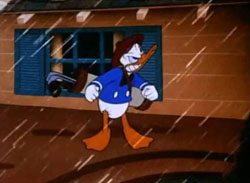 Donald’s eyes narrow momentarily at the shocking image – then, he folds it back inside the pages, and curiously examines the cover of the volume: “Diseases and Their Symptoms.” As if clairvoyant as to Donald’s actions, an announcer takes the microphone on the radio broadcast, stating: “Are you a well man? You may think so, but you probably need a doctor. Call Dr. Quack at Main 1-3-0h-0h, ot you may be a dead duck!” With this unnerving statement, Donald turns his attentions to the contents of his book. By now, the nephews have slipped downstairs, and are peering in from behind a curtain to see what their uncle is up to. Donald finds a page reading. “A coated tongue can be a very dangerous sign.” For safety sake, Donald opens his mouth and checks himself out in a wall mirror – forgetting that he has been eating licorice. At seeing his tongue coated solid black, Donald reacts with startled shock. (The animators take liberties with this scene, displaying Donald’s tongue not as the small triangle by which it usually appears, but as a fill-sized human tongue.) Donald anxiously flips to the book’s next page, continuing, “…which may cause a total blackout.” Donald begins to test himself, by covering his eyes with one hand, then seeing if he continues to see when the hand is removed from his eyelids. One of the nephews sees an opportunity for some sadistic fun, and pulls the switch on a wall fuse box into off position. Donald reacts with increased shock as he is temporarily plunged into blackness. The nephew flicks on the power again, and Donald continues with his eye test. This time, the nephew shuts off the power and keeps it off for a good long time. Donald’s eyeballs widen to fill the screen, flashing in several colors of startlement – then the scene is left pitch black. “Help! I can’t see!”, shrieks Donald. When the nephews restore the power again, Donald is stumbling around the living room blindly, as he has forgotten to open his eyes! His foot kicks the boys’ toy train, and the dimwitted duck remembers to open his eyelids long enough to push the train out of the way, then closes them again to resume his blind stumbling. As Donald finally falls to the floor, the nephews rush into the room, pretending to give Donald aid. “Careful, boys. I’m a sick man”, says Donald, as they carry their uncle to lie down on the couch.
Donald’s eyes narrow momentarily at the shocking image – then, he folds it back inside the pages, and curiously examines the cover of the volume: “Diseases and Their Symptoms.” As if clairvoyant as to Donald’s actions, an announcer takes the microphone on the radio broadcast, stating: “Are you a well man? You may think so, but you probably need a doctor. Call Dr. Quack at Main 1-3-0h-0h, ot you may be a dead duck!” With this unnerving statement, Donald turns his attentions to the contents of his book. By now, the nephews have slipped downstairs, and are peering in from behind a curtain to see what their uncle is up to. Donald finds a page reading. “A coated tongue can be a very dangerous sign.” For safety sake, Donald opens his mouth and checks himself out in a wall mirror – forgetting that he has been eating licorice. At seeing his tongue coated solid black, Donald reacts with startled shock. (The animators take liberties with this scene, displaying Donald’s tongue not as the small triangle by which it usually appears, but as a fill-sized human tongue.) Donald anxiously flips to the book’s next page, continuing, “…which may cause a total blackout.” Donald begins to test himself, by covering his eyes with one hand, then seeing if he continues to see when the hand is removed from his eyelids. One of the nephews sees an opportunity for some sadistic fun, and pulls the switch on a wall fuse box into off position. Donald reacts with increased shock as he is temporarily plunged into blackness. The nephew flicks on the power again, and Donald continues with his eye test. This time, the nephew shuts off the power and keeps it off for a good long time. Donald’s eyeballs widen to fill the screen, flashing in several colors of startlement – then the scene is left pitch black. “Help! I can’t see!”, shrieks Donald. When the nephews restore the power again, Donald is stumbling around the living room blindly, as he has forgotten to open his eyes! His foot kicks the boys’ toy train, and the dimwitted duck remembers to open his eyelids long enough to push the train out of the way, then closes them again to resume his blind stumbling. As Donald finally falls to the floor, the nephews rush into the room, pretending to give Donald aid. “Careful, boys. I’m a sick man”, says Donald, as they carry their uncle to lie down on the couch.
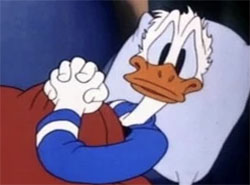 One of the boys politely provides Donald with a hot cup of coffee. Though moaning as if in severe pain, Donald’s imagined condition does not stop the duck from briefly pausing to bop his nephew on the head, because he forgot to add extra lumps of sugar to the coffee. A blanket is pulled up over Donald’s chest – as a tool for more pranks on uncle Donald. One of the nephews produces, out of Donald’s view, a toy hopping rabbit, controlled by a puff of air from a squeeze ball and air tube. Connecting the air tube to a longer hose and a bicycle pump, the nephews wait until Donald closes his eyes again, and slip the rabbit under Donald’s blanket, sitting directly upon Donald’s chest. Then, one of the nephews mans the bicycle pump, sending gusts of air into the rabbit at rapid, regular intervals. With a squishy-sounding squeak, the rabbit begins hopping under the blanket. “My heart”, responds a panicked Donald. “There goes the old ticker.” The rabbit begins to move around up and down Donald’s chest uncontrollably, then rises to a level where Donald thinks his heart is moving into his throat. Donald swallows hard with his Adam’s apple to force the “heart” back down into its proper location. The nephew manning the pump then changes the rhythm to irregular, punctuating trios of short beats with one long squawking beat – then stops pumping altogether. Donald begins gasping for air, thinking he is having a heart attack. Mercifully, the nephew gives a little, pathetic-sounding push of air back into the rabbit, allowing Donald to breathe a temporary sigh of relief. But then, the torture resumes, as the nephew pours a supply of water into the bicycle pump, making the rabbit’s squeaks sound like a coronary artery has just burst.
One of the boys politely provides Donald with a hot cup of coffee. Though moaning as if in severe pain, Donald’s imagined condition does not stop the duck from briefly pausing to bop his nephew on the head, because he forgot to add extra lumps of sugar to the coffee. A blanket is pulled up over Donald’s chest – as a tool for more pranks on uncle Donald. One of the nephews produces, out of Donald’s view, a toy hopping rabbit, controlled by a puff of air from a squeeze ball and air tube. Connecting the air tube to a longer hose and a bicycle pump, the nephews wait until Donald closes his eyes again, and slip the rabbit under Donald’s blanket, sitting directly upon Donald’s chest. Then, one of the nephews mans the bicycle pump, sending gusts of air into the rabbit at rapid, regular intervals. With a squishy-sounding squeak, the rabbit begins hopping under the blanket. “My heart”, responds a panicked Donald. “There goes the old ticker.” The rabbit begins to move around up and down Donald’s chest uncontrollably, then rises to a level where Donald thinks his heart is moving into his throat. Donald swallows hard with his Adam’s apple to force the “heart” back down into its proper location. The nephew manning the pump then changes the rhythm to irregular, punctuating trios of short beats with one long squawking beat – then stops pumping altogether. Donald begins gasping for air, thinking he is having a heart attack. Mercifully, the nephew gives a little, pathetic-sounding push of air back into the rabbit, allowing Donald to breathe a temporary sigh of relief. But then, the torture resumes, as the nephew pours a supply of water into the bicycle pump, making the rabbit’s squeaks sound like a coronary artery has just burst.
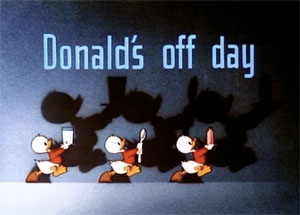 “Come to me, boys. My time is growing short”, beckons Donald. The boys surround him, while Donald reaches to a painting above the sofa, revealing a combination-locked wall safe behind it. Opening the safe door, he produces his last will and testament, adding, “You boys will get everything.” “Everything” refers to a testate gift in the will’s provisions of his beloved set of golf clubs. To make Donald’s “passing” more easy to bear, they carry to him the clubs, so Donald can clutch them tenderly in a last fond goodbye (at which he sheds a tear). Then, they decide to finish Donald off for good, really pouring on the energy upon the bicycle pump to increase the “heartbeat” to a breakneck speed. Donald is sure he’s done for, but the unexpected happens. The toy rabbit pops out from under the blanket, landing in Donald’s hand. Donald is on the verge of utter madness, believing his heart has leaped out of his body, and is barely able to bring himself to peek with one eye to view this horrific sight. When he spots the rabbit instead, terror converts to a desire for savage revenge. Tracing the air hose from the rabbit to the floor behind the sofa, Donald tugs at the hose to see what is on the other end. He drags into view the nephew on the pump, who remains unaware he is being towed into Donald’s view. Seeing a face now staring beside him, the nephew briefly mistakes it for one of his siblings, and flashes Donald a knowing wink as if acknowledging one of his co-conspirators. Suddenly, the nephew realizes what he’s just given away in information to Donald, and jumps back in panic, joining his siblings in a defensive position huddled in a corner. Donald rises from the sofa, stomping his way closer, ever closer to the nephews, as a thundercloud of imagery emits from his brain, showing him recalling all the events of the afternoon, which he now realizes were the boys’ mischief in action. Donald looms over the boys in the darkened corner, his arms reaching out to commit the most fiendish bodily harm, but in a blink, the room transforms from darkness to light. The sun is out again, and streaming its light upon Donald through a window. “Whoopee!” shouts Donald, grabbing up his clubs again, and racing for the door. From an interior shot, we watch Donald exit the house, shutting the door behind him. In a creative effect, the view from windows around the door transforms in an instant to dark clouds again, and the imagery of a bolt of lightning blasting a figure in the shape of a duck is seen, from its sheer power, through the solid wood of the door! A moment later, the bedraggled Donald stumbles back into the house, only having enough energy left to muster a half-hearted, pathetic laugh to the audience, as we iris out.
“Come to me, boys. My time is growing short”, beckons Donald. The boys surround him, while Donald reaches to a painting above the sofa, revealing a combination-locked wall safe behind it. Opening the safe door, he produces his last will and testament, adding, “You boys will get everything.” “Everything” refers to a testate gift in the will’s provisions of his beloved set of golf clubs. To make Donald’s “passing” more easy to bear, they carry to him the clubs, so Donald can clutch them tenderly in a last fond goodbye (at which he sheds a tear). Then, they decide to finish Donald off for good, really pouring on the energy upon the bicycle pump to increase the “heartbeat” to a breakneck speed. Donald is sure he’s done for, but the unexpected happens. The toy rabbit pops out from under the blanket, landing in Donald’s hand. Donald is on the verge of utter madness, believing his heart has leaped out of his body, and is barely able to bring himself to peek with one eye to view this horrific sight. When he spots the rabbit instead, terror converts to a desire for savage revenge. Tracing the air hose from the rabbit to the floor behind the sofa, Donald tugs at the hose to see what is on the other end. He drags into view the nephew on the pump, who remains unaware he is being towed into Donald’s view. Seeing a face now staring beside him, the nephew briefly mistakes it for one of his siblings, and flashes Donald a knowing wink as if acknowledging one of his co-conspirators. Suddenly, the nephew realizes what he’s just given away in information to Donald, and jumps back in panic, joining his siblings in a defensive position huddled in a corner. Donald rises from the sofa, stomping his way closer, ever closer to the nephews, as a thundercloud of imagery emits from his brain, showing him recalling all the events of the afternoon, which he now realizes were the boys’ mischief in action. Donald looms over the boys in the darkened corner, his arms reaching out to commit the most fiendish bodily harm, but in a blink, the room transforms from darkness to light. The sun is out again, and streaming its light upon Donald through a window. “Whoopee!” shouts Donald, grabbing up his clubs again, and racing for the door. From an interior shot, we watch Donald exit the house, shutting the door behind him. In a creative effect, the view from windows around the door transforms in an instant to dark clouds again, and the imagery of a bolt of lightning blasting a figure in the shape of a duck is seen, from its sheer power, through the solid wood of the door! A moment later, the bedraggled Donald stumbles back into the house, only having enough energy left to muster a half-hearted, pathetic laugh to the audience, as we iris out.
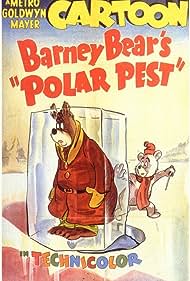 Barney Bear’s Polar Pest (MGM, Barney Bear, 12/30/44 – George Gordon, dir.) – Surrounded by snowdrifts, and with new snow continuing to fall, we find Barney Bear’s log cabin, with a prominent sign tacked to the door, reading “Do Not Disturb – Asleep for the winter.” Inside, Barney lies in bed with his usual covering of about 20 blankets, warm and cozy. A knock at the door spells trouble. Barney rises groggily, and opens the front door – and is instantly jarred fully awake by a gale-force blast of wind and driving snow. Barney struggles to shut the door again, bolting it – but turns around to observe, to his startlement, literally what the wind blew in. A small polar bear, in scarf and cloth hat, stands at the foot of his bed. He introduces himself as Barney’s nephew, come to spend the winter with him. “Ain’cha glad?” he asks Barney. Barney’s reaction is exactly the opposite. He moans, claps his hands over his eyes, and hesitantly peeps out from between his fingers, hoping the image will disappear. “What’s a-matter? Are you sick?”, asks the polar bear, as he loosens his scarf, and fans himself with his cloth hat. “No wonder. It’s too hot in here”, he continues. The little bear decides to fix this problem, walking over to a window and opening it. More icy blasts pour into the room, and Barney hustles to close the window fast. But as soon as he’s closed one, the little bear has opened another. Barney slams the second window shut with such force, he breaks it. To keep out the snow, Barney begins tacking up an old pair of blue jeans (with a sizeable patch in the pants seat) oveer the hole, never noticing that in the meanwhile, the little bear has opened the front door, and is vigorously inhaling the refreshingly cold air from outside. Just as Barney completes his tacking job, the little bear calls to him, and playfully hits Barney in the face with a snowball. Behind Barney’s back, that patch in the blue jeans gives way, and a flurry of snow blows in and up inside of Barney’s nightshirt, turning the helpless bear blue and causing his teeth to chatter uncontrollably.
Barney Bear’s Polar Pest (MGM, Barney Bear, 12/30/44 – George Gordon, dir.) – Surrounded by snowdrifts, and with new snow continuing to fall, we find Barney Bear’s log cabin, with a prominent sign tacked to the door, reading “Do Not Disturb – Asleep for the winter.” Inside, Barney lies in bed with his usual covering of about 20 blankets, warm and cozy. A knock at the door spells trouble. Barney rises groggily, and opens the front door – and is instantly jarred fully awake by a gale-force blast of wind and driving snow. Barney struggles to shut the door again, bolting it – but turns around to observe, to his startlement, literally what the wind blew in. A small polar bear, in scarf and cloth hat, stands at the foot of his bed. He introduces himself as Barney’s nephew, come to spend the winter with him. “Ain’cha glad?” he asks Barney. Barney’s reaction is exactly the opposite. He moans, claps his hands over his eyes, and hesitantly peeps out from between his fingers, hoping the image will disappear. “What’s a-matter? Are you sick?”, asks the polar bear, as he loosens his scarf, and fans himself with his cloth hat. “No wonder. It’s too hot in here”, he continues. The little bear decides to fix this problem, walking over to a window and opening it. More icy blasts pour into the room, and Barney hustles to close the window fast. But as soon as he’s closed one, the little bear has opened another. Barney slams the second window shut with such force, he breaks it. To keep out the snow, Barney begins tacking up an old pair of blue jeans (with a sizeable patch in the pants seat) oveer the hole, never noticing that in the meanwhile, the little bear has opened the front door, and is vigorously inhaling the refreshingly cold air from outside. Just as Barney completes his tacking job, the little bear calls to him, and playfully hits Barney in the face with a snowball. Behind Barney’s back, that patch in the blue jeans gives way, and a flurry of snow blows in and up inside of Barney’s nightshirt, turning the helpless bear blue and causing his teeth to chatter uncontrollably.
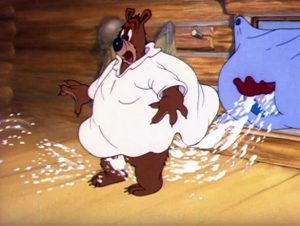 Barney is next seen sitting with his feet in a pail of hot water, and bundled under a blanket, trying to fight off the trembles. The little bear busies himself by pretending to fish with a fishing rod he finds in the house. He casts out the line, snagging a mounted fish on a wall plaque, then reels in, slapping Barney in the face with it. The nephew suggests that uncle Barney take him ice fishing. “Do, Do, Do!” Barney shouts, unable to pronounce an “N” due to the cold in his nose. But the persistent cub slides Barney toward the front door, and Barney finds himself on an outing, like it or not. Barney can’t even make a graceful exit from the cabin, getting buried by a load of snow from the front porch roof, and slipping on the icy front step to slide into the post of his mailbox, out of which slides a half-cylinder of solid ice to conk Barney on the head. Arriving at the frozen river, Barney proves himself a rank amateur at the sport, sawing a hole in the ice, but forgetting to step out of the center before completing the circle, causing him to fall in. Barney rises from the water, encased in a giant block of ice. The little bear tries to rescue him, by hammering an ice pick into the block – which only scores a direct hit on Barney’s rear end. Barney leaps out of the ice block and high into the air in pain, but lands right back in the hole he made in the block, and submerges again. When he resurfaces, he is not only re-frozen into the block, but the block stands atop a column of frozen water created from the wave created from Barney’s impact with the water. The little bear grabs an axe, and starts chopping away at the ice column. Barney’s ice cube topples and falls, sliding along uncontrolled along the river surface. It passes through an arc formed by a bent sapling tree whose upper branches have somehow gotten stuck in the river ice, then careens at top speed toward the drop-off point of a huge waterfall.
Barney is next seen sitting with his feet in a pail of hot water, and bundled under a blanket, trying to fight off the trembles. The little bear busies himself by pretending to fish with a fishing rod he finds in the house. He casts out the line, snagging a mounted fish on a wall plaque, then reels in, slapping Barney in the face with it. The nephew suggests that uncle Barney take him ice fishing. “Do, Do, Do!” Barney shouts, unable to pronounce an “N” due to the cold in his nose. But the persistent cub slides Barney toward the front door, and Barney finds himself on an outing, like it or not. Barney can’t even make a graceful exit from the cabin, getting buried by a load of snow from the front porch roof, and slipping on the icy front step to slide into the post of his mailbox, out of which slides a half-cylinder of solid ice to conk Barney on the head. Arriving at the frozen river, Barney proves himself a rank amateur at the sport, sawing a hole in the ice, but forgetting to step out of the center before completing the circle, causing him to fall in. Barney rises from the water, encased in a giant block of ice. The little bear tries to rescue him, by hammering an ice pick into the block – which only scores a direct hit on Barney’s rear end. Barney leaps out of the ice block and high into the air in pain, but lands right back in the hole he made in the block, and submerges again. When he resurfaces, he is not only re-frozen into the block, but the block stands atop a column of frozen water created from the wave created from Barney’s impact with the water. The little bear grabs an axe, and starts chopping away at the ice column. Barney’s ice cube topples and falls, sliding along uncontrolled along the river surface. It passes through an arc formed by a bent sapling tree whose upper branches have somehow gotten stuck in the river ice, then careens at top speed toward the drop-off point of a huge waterfall.
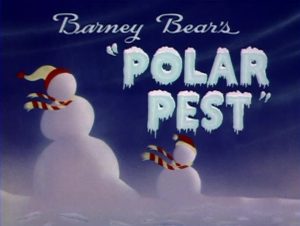 Among Barney’s fishing equipment conveniently happens to be a harpoon and rope. The polar bear thrusts the harpoon through the air, penetrating the top of Barney’s ice cube and spearing Barney’s fur hat, stopping the ice cube just short of plunging over the falls. The little bear ties off the other end of the harpoon rope to the bent sapling, then works with Barney’s ice saw to cut away at the limbs holding down the tree top into the ice. Barney, able to see the waterfall before him from inside the ice cube, screams silently for help, until the force of his scream pops a hole in the cube to let the sound escape. The vapor from a second scream freezes in mid air in the shape of the letters “H-E-L-P”, then the letters crack away and fall into the canyon below. Ice cracks away from below Barney’s position, leaving the ice cube dangling precariously over the falls’ edge from the harpoon rope. The cub finally saws through the sapling limbs, reeling in the ice cube, which breaks open, leaving Barney helplessly sliding upon the river ice on his belly. The cub somehow manages to land astride Barney’s back, steering his uncle by the ears, over a hazardous course above and below the ice surface, and finally through a snowdrift and off a mountain slope, where the cub is ejected from Barney’s back, and Barney is transformed into a rolling snowball. Outracing his uncle downhill, the cub opens the gate and front door of Barney’s cabin, as Barney rolls inside with an audible crash. “I guess I’d better be going now”, the cub stammers nervously, and bids a hasty goodbye, then retreats, as the camera cuts to an interior view of Barney’s fireplace. The snowball has acquired two broomsticks for arms, two logs for legs, and several lumps of coal to form a face and buttons, transforming into an indoor snowman in the fireplace, as Barney’s head emerges from the ball in disgust, and waits for the fire below to thaw him out of his predicament.
Among Barney’s fishing equipment conveniently happens to be a harpoon and rope. The polar bear thrusts the harpoon through the air, penetrating the top of Barney’s ice cube and spearing Barney’s fur hat, stopping the ice cube just short of plunging over the falls. The little bear ties off the other end of the harpoon rope to the bent sapling, then works with Barney’s ice saw to cut away at the limbs holding down the tree top into the ice. Barney, able to see the waterfall before him from inside the ice cube, screams silently for help, until the force of his scream pops a hole in the cube to let the sound escape. The vapor from a second scream freezes in mid air in the shape of the letters “H-E-L-P”, then the letters crack away and fall into the canyon below. Ice cracks away from below Barney’s position, leaving the ice cube dangling precariously over the falls’ edge from the harpoon rope. The cub finally saws through the sapling limbs, reeling in the ice cube, which breaks open, leaving Barney helplessly sliding upon the river ice on his belly. The cub somehow manages to land astride Barney’s back, steering his uncle by the ears, over a hazardous course above and below the ice surface, and finally through a snowdrift and off a mountain slope, where the cub is ejected from Barney’s back, and Barney is transformed into a rolling snowball. Outracing his uncle downhill, the cub opens the gate and front door of Barney’s cabin, as Barney rolls inside with an audible crash. “I guess I’d better be going now”, the cub stammers nervously, and bids a hasty goodbye, then retreats, as the camera cuts to an interior view of Barney’s fireplace. The snowball has acquired two broomsticks for arms, two logs for legs, and several lumps of coal to form a face and buttons, transforming into an indoor snowman in the fireplace, as Barney’s head emerges from the ball in disgust, and waits for the fire below to thaw him out of his predicament.
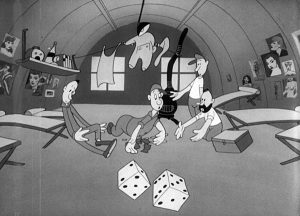 In the Aleutians (Warner, Private Snafu, 2/12/45 – Charles M. (Chuck) Jones, dir.) – Subtitle for this film appears onscreen with the title card: “Isles of Enchantment (Oh Brother!)” A narrator describes Tokyo’s attempt to use these arctic islands as a back door to the U.S., but a symbolic Japanese soldier is stopped cold at a door frame by an American army man, and forced to jump back into the sea. Now, the American looks in reverse through the door as a doorway to Tokyo. In reality, this proved impractical due to the severity of weather conditions – a subject treated throughout this film. “Bountiful Mother Nature has endowed these islands with all the rich variety of weather from her abundant storehouse – in fact, the old bag blew her top!” This comment from the narrator is accompanied by view of a typical island, enduring in a matter of seconds images of high winds, rain, blizzard, cyclone, lightning, and what-have-you. “Almost unbelievable”, remarks the narrator, The camera pulls back to a walrus on a rock, who turns to the audience, revealing a face resembling Jimmy Durante, and responds, :Nevertheless, dat’s the conditions dat prevail.” Running gag (literally) involves Snafu (who has no dialogue in this picture), facing the problem of what to wear as he sets out for an important mission. He walks on and on, never missing a step, but has perfected the art of quick-change, transforming his wardrobe from army fatigues to parka and skis to bathing suit and sunglasses to raincoat (complete with windshield wiper in its hood), to helmet equipped with steam foghorn to march through fogbanks. The terrain is described as grass on tundra with no trees. “You’re telling me”, comments a twin to Charlie Dog. Thick gummy mud also gums things up, but one soldier seeming to trudge through it, says he doesn’t mind – because he is revealed to be sitting on the shoulders of another soldier completely submerged in it – who hates it. As the second soldier is revealed, he points further downward, stating, “Claude don’t like it neither”, suggesting a third soldier submerged even further below. Earthquakes rock the region, having a negative effect on dice games in the barracks, as a roll of a seven is re-shaken by a quake, converting the roll to snake eyes. Passing winds (or willywogs) wipe a military installation clear off the map. Planes form ice on the wings and tail, leading to a variation of Tex Avery’s gag from Ceiling Hero as the camera reveals an Eskimo ice fishing through a hole he has sawed in the plane’s tail stabilizer. Snafu finally reaches his destination, dealing with constantly-flooded plane runways by making one more quick-change into a deep sea diver’s suit, and joining up with a bomber completely submerged in a puddle The plane takes off from out of the water, leaving Snafy inside a glass gunner’s turret, mostly underwater and with a goldfish swimming around him. Snafu opens the bomb bay doors and jettisons the fish, who parachutes down, only to be swallowed by the Jimmy Durante walrus for the iris out.
In the Aleutians (Warner, Private Snafu, 2/12/45 – Charles M. (Chuck) Jones, dir.) – Subtitle for this film appears onscreen with the title card: “Isles of Enchantment (Oh Brother!)” A narrator describes Tokyo’s attempt to use these arctic islands as a back door to the U.S., but a symbolic Japanese soldier is stopped cold at a door frame by an American army man, and forced to jump back into the sea. Now, the American looks in reverse through the door as a doorway to Tokyo. In reality, this proved impractical due to the severity of weather conditions – a subject treated throughout this film. “Bountiful Mother Nature has endowed these islands with all the rich variety of weather from her abundant storehouse – in fact, the old bag blew her top!” This comment from the narrator is accompanied by view of a typical island, enduring in a matter of seconds images of high winds, rain, blizzard, cyclone, lightning, and what-have-you. “Almost unbelievable”, remarks the narrator, The camera pulls back to a walrus on a rock, who turns to the audience, revealing a face resembling Jimmy Durante, and responds, :Nevertheless, dat’s the conditions dat prevail.” Running gag (literally) involves Snafu (who has no dialogue in this picture), facing the problem of what to wear as he sets out for an important mission. He walks on and on, never missing a step, but has perfected the art of quick-change, transforming his wardrobe from army fatigues to parka and skis to bathing suit and sunglasses to raincoat (complete with windshield wiper in its hood), to helmet equipped with steam foghorn to march through fogbanks. The terrain is described as grass on tundra with no trees. “You’re telling me”, comments a twin to Charlie Dog. Thick gummy mud also gums things up, but one soldier seeming to trudge through it, says he doesn’t mind – because he is revealed to be sitting on the shoulders of another soldier completely submerged in it – who hates it. As the second soldier is revealed, he points further downward, stating, “Claude don’t like it neither”, suggesting a third soldier submerged even further below. Earthquakes rock the region, having a negative effect on dice games in the barracks, as a roll of a seven is re-shaken by a quake, converting the roll to snake eyes. Passing winds (or willywogs) wipe a military installation clear off the map. Planes form ice on the wings and tail, leading to a variation of Tex Avery’s gag from Ceiling Hero as the camera reveals an Eskimo ice fishing through a hole he has sawed in the plane’s tail stabilizer. Snafu finally reaches his destination, dealing with constantly-flooded plane runways by making one more quick-change into a deep sea diver’s suit, and joining up with a bomber completely submerged in a puddle The plane takes off from out of the water, leaving Snafy inside a glass gunner’s turret, mostly underwater and with a goldfish swimming around him. Snafu opens the bomb bay doors and jettisons the fish, who parachutes down, only to be swallowed by the Jimmy Durante walrus for the iris out.
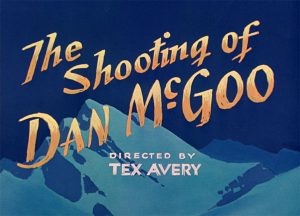 The Shooting of Dan McGoo (MGM (Droopy), 3/3/45 – Tex Avery, dir,) – Avery’s second adaptation of the Robert W. Service poem, “The Shooting of Dan McGrew”. By now, he had introduced a hit character in the form of “Red”, the shapely night club entertainer who had first blown audiences away with her realism in “Red Hot Riding Hood”, and would still have an impact on the industry as the design inspiration for Jessica Rabbit in “Who Framed Roger Rabbit?” So it was only natural that Red would be cast in the role of the lady known as Lou. Egghead was long gone, and the property of another studio, so one of Avery’s newest creations, the rarely-smiling basset hound (or poodle, as he was sometimes referred to), Droopy, takes on te role of Dan in his stead. Avery’s ever-present wolf remains on the cast in his prior role, though now voiced in signature gruff fashion by Frank Graham. All but the first line of Droopy’s dialogue is said by IMDB to have been the work of Avery himself, filling in for an absent Bill Thompson (who may have been under military commitments, possibly accounting for his also leaving the cast of “Fibber McGee and Molly” around this time).
The Shooting of Dan McGoo (MGM (Droopy), 3/3/45 – Tex Avery, dir,) – Avery’s second adaptation of the Robert W. Service poem, “The Shooting of Dan McGrew”. By now, he had introduced a hit character in the form of “Red”, the shapely night club entertainer who had first blown audiences away with her realism in “Red Hot Riding Hood”, and would still have an impact on the industry as the design inspiration for Jessica Rabbit in “Who Framed Roger Rabbit?” So it was only natural that Red would be cast in the role of the lady known as Lou. Egghead was long gone, and the property of another studio, so one of Avery’s newest creations, the rarely-smiling basset hound (or poodle, as he was sometimes referred to), Droopy, takes on te role of Dan in his stead. Avery’s ever-present wolf remains on the cast in his prior role, though now voiced in signature gruff fashion by Frank Graham. All but the first line of Droopy’s dialogue is said by IMDB to have been the work of Avery himself, filling in for an absent Bill Thompson (who may have been under military commitments, possibly accounting for his also leaving the cast of “Fibber McGee and Molly” around this time).
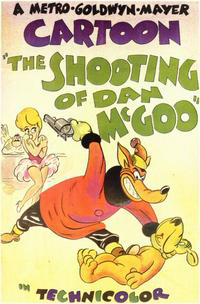 Coldernell, Alaska (a name gag which Avery would frequently use, including in Chilly Willy’s I’m Cold) is a raucous, rip-roaring, snow-covered town. A population counter of the city-limits sign keeps dropping mechanically in number with the sound of every gunshot from the community below. Advertisement for a “double header” stands beside a double hangman’s noose, with a added sign on a smaller noose reading “Kids 15 cents”. More sign gags include a small saloon entrance for “short beers”, and a sign in the main saloon, where an out-of-contol room0wide brawl is taking place, reading “Noisy, isn’t it?” The piano player downs beers like the end of an assembly line, mugs piling up everywhere behind his piano. Dan’s “solo game” has Droopy playing a slot machine, and drawing images of lollipop “Sucker”s on each wheel. Lou (Red) watches close by, wearing across her dress a pennant presented to her for the “Wolf Award”. The boys at the bar order beer which slides down the polished bar in mugs, stopping at a traffic intersection between bars for mug cross-traffic, and for a hopping martini glass crossing in the pedestrian crosswalk. A panning shot reveals the bartender, standing in a crucial spot which blocks view of a painting which we assume is of a barroom nude. “Ya might as well move on, Doc. I don’t move from here all through the picture”, says the dour bartender.
Coldernell, Alaska (a name gag which Avery would frequently use, including in Chilly Willy’s I’m Cold) is a raucous, rip-roaring, snow-covered town. A population counter of the city-limits sign keeps dropping mechanically in number with the sound of every gunshot from the community below. Advertisement for a “double header” stands beside a double hangman’s noose, with a added sign on a smaller noose reading “Kids 15 cents”. More sign gags include a small saloon entrance for “short beers”, and a sign in the main saloon, where an out-of-contol room0wide brawl is taking place, reading “Noisy, isn’t it?” The piano player downs beers like the end of an assembly line, mugs piling up everywhere behind his piano. Dan’s “solo game” has Droopy playing a slot machine, and drawing images of lollipop “Sucker”s on each wheel. Lou (Red) watches close by, wearing across her dress a pennant presented to her for the “Wolf Award”. The boys at the bar order beer which slides down the polished bar in mugs, stopping at a traffic intersection between bars for mug cross-traffic, and for a hopping martini glass crossing in the pedestrian crosswalk. A panning shot reveals the bartender, standing in a crucial spot which blocks view of a painting which we assume is of a barroom nude. “Ya might as well move on, Doc. I don’t move from here all through the picture”, says the dour bartender.
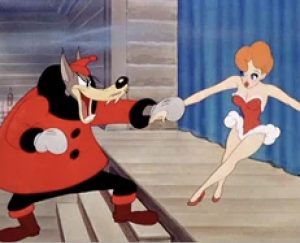 Out of the 50-below night drives up the world’s longest limousine, which seems to extend for blocks as it pulls up in front of the saloon (its door adding yet another sign: “Long, wasn’t it?” (This shot was refilmed on reissue, to eliminate a wartime reference in another sign posted on the saloon doorway, reading “Cigarettes”, with the word crossed out in red, and a handwritten inscription below, “Are you kiddin’?”). The wolf enters the saloon, but we can’t tell at first, as he is completely covered in snow, appearing to be a snowman. Tugging at an invisible zipper, the wolf removes the snow coat, and emerges into full view. He seems to have “one foot in the grave” (depicted literally by a small grave and headstone attached to his foot), but nevertheless slaps a sack of gold onto the bar, and announces the drinks are “on the house”. Everyone else, including the bartender, briefly disappears up the stairs and out an upper story window of the saloon, where they down a round of beer from mugs they find outside on the roof. Returning to the bar, the wolf orders from a bartender, “straight whiskey.” He receives a glass from a bottle marked “Old Blockbuster”. The drink hits his stomach, and explosions light up his insides. His eyes become immediately bloodshot, and he rockets into the upmost rafters like a 4th of July firework, then just as suddenly lands back at the bar, where he angrily seizes the bartender by the collar, and insists “This stuff’s been cut.” Droopy comments from a table “What do you want for fifteen cents? Gasoline?” The wolf now confronts Droopy, remarking “T’ain’t funny, McGoo” (a play on Molly’s catch-phrase whenever Fibber McGee would tell a bad joke).
Out of the 50-below night drives up the world’s longest limousine, which seems to extend for blocks as it pulls up in front of the saloon (its door adding yet another sign: “Long, wasn’t it?” (This shot was refilmed on reissue, to eliminate a wartime reference in another sign posted on the saloon doorway, reading “Cigarettes”, with the word crossed out in red, and a handwritten inscription below, “Are you kiddin’?”). The wolf enters the saloon, but we can’t tell at first, as he is completely covered in snow, appearing to be a snowman. Tugging at an invisible zipper, the wolf removes the snow coat, and emerges into full view. He seems to have “one foot in the grave” (depicted literally by a small grave and headstone attached to his foot), but nevertheless slaps a sack of gold onto the bar, and announces the drinks are “on the house”. Everyone else, including the bartender, briefly disappears up the stairs and out an upper story window of the saloon, where they down a round of beer from mugs they find outside on the roof. Returning to the bar, the wolf orders from a bartender, “straight whiskey.” He receives a glass from a bottle marked “Old Blockbuster”. The drink hits his stomach, and explosions light up his insides. His eyes become immediately bloodshot, and he rockets into the upmost rafters like a 4th of July firework, then just as suddenly lands back at the bar, where he angrily seizes the bartender by the collar, and insists “This stuff’s been cut.” Droopy comments from a table “What do you want for fifteen cents? Gasoline?” The wolf now confronts Droopy, remarking “T’ain’t funny, McGoo” (a play on Molly’s catch-phrase whenever Fibber McGee would tell a bad joke).
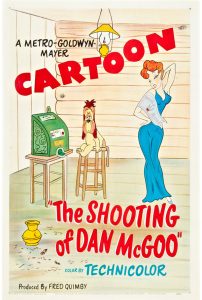 The wolf then adds to the audience, “What corny dialogue.” As the wolf pulls out a six-foot long collapsible penknife to stab McGoo, the scene is interrupted by the appearance of Lou, singing a provocative rendition of “Put Your Arms Around Me, Honey” (with added lyrics for the servicemen of the day). The wolf goes through a string of arousal and reaction gags that are signature Avery trademarks, and better seen than verbally described. One of the best has his eyeballs pop out of their sockets, and fly to the stage to oogle Lou at close range, as she responds with disdain, “Get away, boys. Ya bother me.” Another reanimated scene for reissue registers no laugh, with the wolf pulling out a large box to display to Lou a long jeweled necklace to tempt her to him. In te original, the box contained pack after pack of rationed cigarettes. Finally, the wolf flips out, charges the stage, and declares Lou is his now, and he’ll murder the first bum who says otherwise. An epic gunfight ensues, in which five patrons downing beer at the bar are shot, but their ghosts resume their position drinking at the bar. Even the bartender blocking view of the wall painting breaks his word and flees from the scene, revealing where he stood only a sign in place of a nude torso, reading “I ain’t got no body” (play on a popular song of nearly the same title). The wolf exits the saloon, but runs straight into Droopy, with an oversized revolver pointing at the wolf’s gut. The lights go out, and two shots ring out in the dark. When the lights come up, unlike Avery’s preceding Warner version, Droopy stands with smoking gun, while the wolf lays motionless on the floor with a lily on his chest. “My hero”, says Lou, giving Droopy a kiss. Droopy blushes red, momentarily develops an ear to ear smile, and mimics several of the wolf’s prior reactions, including skyrocketing into the rafters and back down again – where he reverts to normal deadpan form, and blandly remarks. “You know what? I’m happy.”
The wolf then adds to the audience, “What corny dialogue.” As the wolf pulls out a six-foot long collapsible penknife to stab McGoo, the scene is interrupted by the appearance of Lou, singing a provocative rendition of “Put Your Arms Around Me, Honey” (with added lyrics for the servicemen of the day). The wolf goes through a string of arousal and reaction gags that are signature Avery trademarks, and better seen than verbally described. One of the best has his eyeballs pop out of their sockets, and fly to the stage to oogle Lou at close range, as she responds with disdain, “Get away, boys. Ya bother me.” Another reanimated scene for reissue registers no laugh, with the wolf pulling out a large box to display to Lou a long jeweled necklace to tempt her to him. In te original, the box contained pack after pack of rationed cigarettes. Finally, the wolf flips out, charges the stage, and declares Lou is his now, and he’ll murder the first bum who says otherwise. An epic gunfight ensues, in which five patrons downing beer at the bar are shot, but their ghosts resume their position drinking at the bar. Even the bartender blocking view of the wall painting breaks his word and flees from the scene, revealing where he stood only a sign in place of a nude torso, reading “I ain’t got no body” (play on a popular song of nearly the same title). The wolf exits the saloon, but runs straight into Droopy, with an oversized revolver pointing at the wolf’s gut. The lights go out, and two shots ring out in the dark. When the lights come up, unlike Avery’s preceding Warner version, Droopy stands with smoking gun, while the wolf lays motionless on the floor with a lily on his chest. “My hero”, says Lou, giving Droopy a kiss. Droopy blushes red, momentarily develops an ear to ear smile, and mimics several of the wolf’s prior reactions, including skyrocketing into the rafters and back down again – where he reverts to normal deadpan form, and blandly remarks. “You know what? I’m happy.”
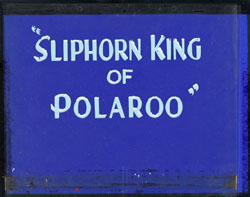 The Sliphorn King of Polaroo (Lantz/Universal, Swing Symphony, 3/19/45 – Dick Lundy, dir.) – Possibly the only instance in Lantz films to hear Lee Sweetland (singing voice of Woody Woodpecker, as noted above) at normal speed, for a short musical introduction to the land of Polaroo – a polar ice community, said to have a “most unusual king”. Two more celebrity performers receive screen bill with Sweetland. Veteran radio comedian/actor Hans Conreid (regular on “My Friend Irma”, among numerous other radio roles, whom we would also later know from Jay Ward television productions “Hoppity Hooper” (as Waldo Wigglesworth) and “Fractured Flickers”, along with regular appearances on the game show “Stump the Stars”) provides about a minute and a half of colorful narration as to how this king came to be. This was not Conreid’s only performance for Lantz, as he would also appear without screen billing as the taxidermist cat in “Woody Dines Out”. Rounding out the talent list is a return engagement for jazz trombone virtuoso/vocalist Jack Teagarden, who had previously performed instrumentally as “The Pied Piper of Basin Street”. Jack was a well-known figure in New Orleans-style jazz interpretation, and had recorded regularly throughout the 1930’s, both as sought-after sideman and briefly fronting his own orchestra, including a distinctive date with a fledgling Benny Goodman organization in which he played and vocalized an arrangement of “Basin Street Blues” which would attain reputation as a jazz classic. During the later 1940’s, he would develop a sort of partnership with Louis Armstrong, which would result in a long series of concert performances and many recording dates of the two augmenting each other perfectly.
The Sliphorn King of Polaroo (Lantz/Universal, Swing Symphony, 3/19/45 – Dick Lundy, dir.) – Possibly the only instance in Lantz films to hear Lee Sweetland (singing voice of Woody Woodpecker, as noted above) at normal speed, for a short musical introduction to the land of Polaroo – a polar ice community, said to have a “most unusual king”. Two more celebrity performers receive screen bill with Sweetland. Veteran radio comedian/actor Hans Conreid (regular on “My Friend Irma”, among numerous other radio roles, whom we would also later know from Jay Ward television productions “Hoppity Hooper” (as Waldo Wigglesworth) and “Fractured Flickers”, along with regular appearances on the game show “Stump the Stars”) provides about a minute and a half of colorful narration as to how this king came to be. This was not Conreid’s only performance for Lantz, as he would also appear without screen billing as the taxidermist cat in “Woody Dines Out”. Rounding out the talent list is a return engagement for jazz trombone virtuoso/vocalist Jack Teagarden, who had previously performed instrumentally as “The Pied Piper of Basin Street”. Jack was a well-known figure in New Orleans-style jazz interpretation, and had recorded regularly throughout the 1930’s, both as sought-after sideman and briefly fronting his own orchestra, including a distinctive date with a fledgling Benny Goodman organization in which he played and vocalized an arrangement of “Basin Street Blues” which would attain reputation as a jazz classic. During the later 1940’s, he would develop a sort of partnership with Louis Armstrong, which would result in a long series of concert performances and many recording dates of the two augmenting each other perfectly.
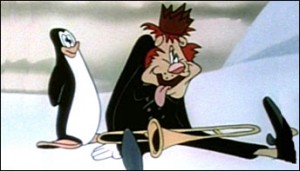 The tale of the king begins somewhere upon the ocean in the far North, where a small ship encounters an arctic gale that begins with a waterspout, then tosses the ship with frothy whitecap hands from “stem to stern and stern to stem.” As the ship bobs helplessly upon the waves, a lone voice is heard from the deck, screaming “HELP!!!” – whom the narrator identifies in somewhat derogatory tone as “a trombone player by the name of Jackson.” Depicted as a lion in a dance-band tuxedo, Jackson rescues his beloved trombone from the ship’s cabin, then “springs” from the deck (his feet briefly changing into bedsprings). Upon striking the icy water, Jackson “becomes stiff – but this was no new experience for Jackson” (suggesting that Jackson has experienced this before from intoxication). Now, Jackson struggles for his lfge in a battle against the elements, using his trombone to blow through as a method of backwards propulsion. But, as the narrator continues, “The elements win, because an element never forgets.” Jackson is hurled by a wave into the side of a wall of solid ice upon land, and lies unconscious on the snow-covered shore. “Then came the dawn”, as we see the sun propelled into the air out of the ocean by means of an oversize glove attached to a telephone extender, pushing it upwards in a split second. The natives of the island (penguins, again at the wrong pole), “bring him two”. Yes, “two”, not “to”, carrying to Jackson two fifths of booze on a tray. “Then they bring him two more. Then they give him the bottle.” The bottle, however, is not just handed to him, but smashed over his head. This is for a pirpose, as one of the penguins uses the jagged-edged bottle bottom to place upon his head as a crown. Thinking him a god, the natives proclaim him king – and the remainder of the film is a musical romp on a typical day in his kingdom. Teagarden performs double duty, playing trombone to provide the musical serenade of Jackson to his subjects, while singing to provide the voice of a top-hatted seal who introduces the audience to his majesty. Penguin designs for this film, particularly of a prominent penguin in a red stocking cap, would be revived to provide the model for Paul J. Smith’s introduction of the character Chilly Willy in the 1950’s, before Tex Avery redesigned the character into his current well-known form. There are several clever gags, including a walrus who uses a bathtub-shaped hole cut in thie ice to take a bath, emerging with his torso encased in an ice cube, which he ontinues to scrub with a back brush. A “polar bar” offers mixed drinks, concocted by pouring all the ingredients raw into the mouth of the paying patron, shaking him well, then pinning a slice of citrus upon his nose. An ice-fishing walrus randomly pulls up a Southern-dialect alligator, who apologetically asks between trembles which is the way to Florida. Running gags include a penguin who produces a near-infinite line of duplicate penguins who pop up behind him in his dance, only to have the last of them keep tumbling over, to knock down the row like dominoes. Also, the stocking-hat penguin keeps trying to take a turn playing Jackson’s trombone, but never seems to get out a note, as he keeps blowing-off the metal slide from the instrument. At the end of the film, Jackson finally assists him by himself holding the slide in position while the pengion blows, and the little bird produces some long, sweet notes – causing Jackson to present him with a medal, reading “Jackson Jr.”
The tale of the king begins somewhere upon the ocean in the far North, where a small ship encounters an arctic gale that begins with a waterspout, then tosses the ship with frothy whitecap hands from “stem to stern and stern to stem.” As the ship bobs helplessly upon the waves, a lone voice is heard from the deck, screaming “HELP!!!” – whom the narrator identifies in somewhat derogatory tone as “a trombone player by the name of Jackson.” Depicted as a lion in a dance-band tuxedo, Jackson rescues his beloved trombone from the ship’s cabin, then “springs” from the deck (his feet briefly changing into bedsprings). Upon striking the icy water, Jackson “becomes stiff – but this was no new experience for Jackson” (suggesting that Jackson has experienced this before from intoxication). Now, Jackson struggles for his lfge in a battle against the elements, using his trombone to blow through as a method of backwards propulsion. But, as the narrator continues, “The elements win, because an element never forgets.” Jackson is hurled by a wave into the side of a wall of solid ice upon land, and lies unconscious on the snow-covered shore. “Then came the dawn”, as we see the sun propelled into the air out of the ocean by means of an oversize glove attached to a telephone extender, pushing it upwards in a split second. The natives of the island (penguins, again at the wrong pole), “bring him two”. Yes, “two”, not “to”, carrying to Jackson two fifths of booze on a tray. “Then they bring him two more. Then they give him the bottle.” The bottle, however, is not just handed to him, but smashed over his head. This is for a pirpose, as one of the penguins uses the jagged-edged bottle bottom to place upon his head as a crown. Thinking him a god, the natives proclaim him king – and the remainder of the film is a musical romp on a typical day in his kingdom. Teagarden performs double duty, playing trombone to provide the musical serenade of Jackson to his subjects, while singing to provide the voice of a top-hatted seal who introduces the audience to his majesty. Penguin designs for this film, particularly of a prominent penguin in a red stocking cap, would be revived to provide the model for Paul J. Smith’s introduction of the character Chilly Willy in the 1950’s, before Tex Avery redesigned the character into his current well-known form. There are several clever gags, including a walrus who uses a bathtub-shaped hole cut in thie ice to take a bath, emerging with his torso encased in an ice cube, which he ontinues to scrub with a back brush. A “polar bar” offers mixed drinks, concocted by pouring all the ingredients raw into the mouth of the paying patron, shaking him well, then pinning a slice of citrus upon his nose. An ice-fishing walrus randomly pulls up a Southern-dialect alligator, who apologetically asks between trembles which is the way to Florida. Running gags include a penguin who produces a near-infinite line of duplicate penguins who pop up behind him in his dance, only to have the last of them keep tumbling over, to knock down the row like dominoes. Also, the stocking-hat penguin keeps trying to take a turn playing Jackson’s trombone, but never seems to get out a note, as he keeps blowing-off the metal slide from the instrument. At the end of the film, Jackson finally assists him by himself holding the slide in position while the pengion blows, and the little bird produces some long, sweet notes – causing Jackson to present him with a medal, reading “Jackson Jr.”
(Shhhh! You can watch the film here!)
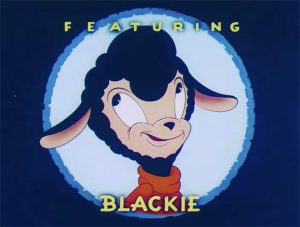 A Lamb in a Jam (Paramount/Famous, Noveltoon (Blackie), 5/4/45 – I. Sparber, dir.) – Set in the dead of winter, though featuring no actual storm activity, this film receives very honorable mention, as a delightfully brisk and clever romp in which Wolfie, the regilar nemesis of Blackie the Black Sheep, has unusual motivations different from his regular appetite for lamb chops. He simply needs a nice warm woolen coat, to keep from freezing his tail off during the winter. Where better to get raw material than from the local lamb community. So, the film opens with him in hot (that is, cold) pursuit of Blackie’s three white sheep friends, armed with an oversize set of sheep shears. The pursuit takes him across the surface of a frozen ice pond, where Blackie just happens to be engaged in a little ice fishing. As Wolfie approaches, Blackie gives the edge of the hole which he has cut in the ice a swift kick (as if the opening into the water were a movable solid object such as a manhole cover), magically sliding the open hole several feet, repositioning it between Wolfie and the sheep he pursues. Splash! Wolfie doesn’t fall completely in, but winds up with freezing ice all over his back, and turning blue. He spots Blackie, and envisions his dream coat upgraded to $200 black Persian wool. He quickly grabs up the meddlesome sheep, threatening him with the shears. Blackie points to his red shirt, and tries to convince the wolf that he’s really half cotton. Wolfie is not fooled, and Blackie admits the customer is always right, but first offers to model in the wool to be sure Wolfie will be satisfied before he removes it. Blackie fluffs himself up and struts his stuff like a fashion show. Wolfie is fully satisfied, and utters the regrettable words, “Let me have it.” POW, as Blackie brings down a mallet on Wolfie, socking him through the ice into the freezing water again.
A Lamb in a Jam (Paramount/Famous, Noveltoon (Blackie), 5/4/45 – I. Sparber, dir.) – Set in the dead of winter, though featuring no actual storm activity, this film receives very honorable mention, as a delightfully brisk and clever romp in which Wolfie, the regilar nemesis of Blackie the Black Sheep, has unusual motivations different from his regular appetite for lamb chops. He simply needs a nice warm woolen coat, to keep from freezing his tail off during the winter. Where better to get raw material than from the local lamb community. So, the film opens with him in hot (that is, cold) pursuit of Blackie’s three white sheep friends, armed with an oversize set of sheep shears. The pursuit takes him across the surface of a frozen ice pond, where Blackie just happens to be engaged in a little ice fishing. As Wolfie approaches, Blackie gives the edge of the hole which he has cut in the ice a swift kick (as if the opening into the water were a movable solid object such as a manhole cover), magically sliding the open hole several feet, repositioning it between Wolfie and the sheep he pursues. Splash! Wolfie doesn’t fall completely in, but winds up with freezing ice all over his back, and turning blue. He spots Blackie, and envisions his dream coat upgraded to $200 black Persian wool. He quickly grabs up the meddlesome sheep, threatening him with the shears. Blackie points to his red shirt, and tries to convince the wolf that he’s really half cotton. Wolfie is not fooled, and Blackie admits the customer is always right, but first offers to model in the wool to be sure Wolfie will be satisfied before he removes it. Blackie fluffs himself up and struts his stuff like a fashion show. Wolfie is fully satisfied, and utters the regrettable words, “Let me have it.” POW, as Blackie brings down a mallet on Wolfie, socking him through the ice into the freezing water again.
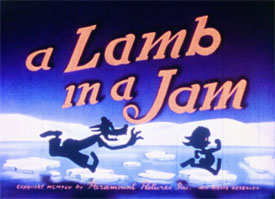 Wolfie is next seen speeding along on skates, though we do not see who he is pursuing. Suddenly from nowhere, a police whistle is heard from behind him. Wolfie “slams on the brakes” with his skates, which develop enough friction in their sideways slide on the ice surface to somehow become red hot, then melt slowly into the ice surface, the water refreezing over Wolfie’s feet to strand him in the ice. The “officer” catches up to Wolfie, and is of course Blackie, his face partially masked from view by an oversized Keystone Kops helmet. He issues a ticket for speeding, which will cost the wolf ten dollars. Wolfie hands over the dough – then Blackie stuffs a large object into Wolfie’s mouth, and departs post haste. Wolfie pulls the object out of his mouth, discovering an all-day “Sucker”. Blackie, now minus disguise, skates away, lighting a cigar by setting Wolfie’s $10 bill on fire (i.e., money to burn). Suddenly, Blackie’s progress is halted, by a fish line and hook cast into his red shirt by Wolhie, who, still stick in the ice, begins to reel in. He gets an unexpected catch, when Blackie rehooks the line to the limb of a dead tree, which topples over onto the ice, taking Wolfie with it into the water below. Blackie appears at the hole, and places a signpost into the open water, reading “Frozen for the duration.” “Too bad”, he comments. “I hope nothin’ happened to him that ain’t fatal.”
Wolfie is next seen speeding along on skates, though we do not see who he is pursuing. Suddenly from nowhere, a police whistle is heard from behind him. Wolfie “slams on the brakes” with his skates, which develop enough friction in their sideways slide on the ice surface to somehow become red hot, then melt slowly into the ice surface, the water refreezing over Wolfie’s feet to strand him in the ice. The “officer” catches up to Wolfie, and is of course Blackie, his face partially masked from view by an oversized Keystone Kops helmet. He issues a ticket for speeding, which will cost the wolf ten dollars. Wolfie hands over the dough – then Blackie stuffs a large object into Wolfie’s mouth, and departs post haste. Wolfie pulls the object out of his mouth, discovering an all-day “Sucker”. Blackie, now minus disguise, skates away, lighting a cigar by setting Wolfie’s $10 bill on fire (i.e., money to burn). Suddenly, Blackie’s progress is halted, by a fish line and hook cast into his red shirt by Wolhie, who, still stick in the ice, begins to reel in. He gets an unexpected catch, when Blackie rehooks the line to the limb of a dead tree, which topples over onto the ice, taking Wolfie with it into the water below. Blackie appears at the hole, and places a signpost into the open water, reading “Frozen for the duration.” “Too bad”, he comments. “I hope nothin’ happened to him that ain’t fatal.”
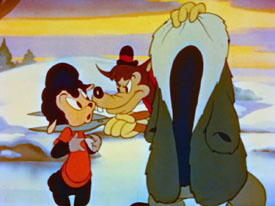 Suddenly, Blackie finds himself lifted off the ground by the neck, his head trapped between the blades of Wolfie’s shears. The wolf has somehow escaped the water, and appeared by surprise in front of him. Blackie does some fast talking, insisting that his wool doesn’t even keep Blackie himself warm. “I’m shakin’ like a leaf”, he insists, his torso transforming into just such an image. However, he tells Wolfie he knows where a genuine fur coat can be had. Blackie conducts Wolfie to the entrance of a cave, and instructs Wolfie to enter and help himself. Wolfue darts inside with his shears, emerging with something large upon which he begins cutting – a sleeping bear. When Wolfie is finished, the bear is minus his fur, and reduced to an outfit of red flannel underwear. Realization finally hits Wolfie as he looks up into the bear’s snarling face, and Wolfie breaks into a sheepish, apologetic grin. He grabs a few mere handfuls of the shorn fur, and presses them to the bear’s belly, then nervously remarks, “As good as new.” The bear doesn’t agree, taking up the fallen fur around his feet, and stuffing it down Wolfie’s throat, then lighting a loose fur wad sticking out of Wolfie’s mouth like a cigar. At the cue of the smoke from the lit fur, Blackie appears in a fireman’s hat, imitating the sound of a fire bell, while pushing Wolfie along the snow, back to the ice pond, to extinguish the blaze by sliding Wolfie into the icy water again. Blackie calmly skates away, until his skates develop super speed, dragging him along to another hole in the ice, from which Wolfie appears, still with a grip on Blackie’s skates by use of a magnet he has been dragging underwater.
Suddenly, Blackie finds himself lifted off the ground by the neck, his head trapped between the blades of Wolfie’s shears. The wolf has somehow escaped the water, and appeared by surprise in front of him. Blackie does some fast talking, insisting that his wool doesn’t even keep Blackie himself warm. “I’m shakin’ like a leaf”, he insists, his torso transforming into just such an image. However, he tells Wolfie he knows where a genuine fur coat can be had. Blackie conducts Wolfie to the entrance of a cave, and instructs Wolfie to enter and help himself. Wolfue darts inside with his shears, emerging with something large upon which he begins cutting – a sleeping bear. When Wolfie is finished, the bear is minus his fur, and reduced to an outfit of red flannel underwear. Realization finally hits Wolfie as he looks up into the bear’s snarling face, and Wolfie breaks into a sheepish, apologetic grin. He grabs a few mere handfuls of the shorn fur, and presses them to the bear’s belly, then nervously remarks, “As good as new.” The bear doesn’t agree, taking up the fallen fur around his feet, and stuffing it down Wolfie’s throat, then lighting a loose fur wad sticking out of Wolfie’s mouth like a cigar. At the cue of the smoke from the lit fur, Blackie appears in a fireman’s hat, imitating the sound of a fire bell, while pushing Wolfie along the snow, back to the ice pond, to extinguish the blaze by sliding Wolfie into the icy water again. Blackie calmly skates away, until his skates develop super speed, dragging him along to another hole in the ice, from which Wolfie appears, still with a grip on Blackie’s skates by use of a magnet he has been dragging underwater.
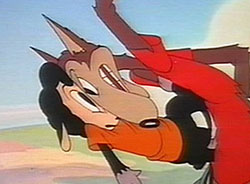 The scene shifts to the interior of Wolfie’s home, with Blackie tied to a post, and a thread from his wool trailing down to the floor, where it is being slowly pulled in by a pair of knitting needles in use by the wolf. Blackie pleads that “Nobody likes cold lamb chops”, but notices that the wolf is no seamstress, having only so far knit a small patch of fabric about two inches square, and in total confusion in his count whether to knit, purl, or drop stitches. Blackie comments that by the time he finishes, his digits will be frozen rigid. “So what?” retorts the wolf. “Can you do better?” Blackie states he can have a coat finished in ten seconds – provided the wolf doesn’t peek at his process. Grabbing a jug of molasses and the stuffings out of an old plush chair, Blackie produces a huge, boxy-looking coat. “Put me in that” responds Wolfie. Blackie obliges, slamming a lapel like a solid door – which in fact it is. Blackie has shut Wolfie into an electric freezer, which he merely camouflaged with a coating of the chair stuffing – and leaves the wolf to deep freeze blue. In a surprise off-the-wall ending (similar to another surprise ending of Blackie’s first picture, No Mutton for Nuttin’, a “The End” card slides into the scene, illuminated by a single light bulb hanging from the ceiling in the foreground. Blackie appears, pulls out a revolver, and shoots the light bulb, plunging the theater into black, for the final fade in of the Paramount mountain.
The scene shifts to the interior of Wolfie’s home, with Blackie tied to a post, and a thread from his wool trailing down to the floor, where it is being slowly pulled in by a pair of knitting needles in use by the wolf. Blackie pleads that “Nobody likes cold lamb chops”, but notices that the wolf is no seamstress, having only so far knit a small patch of fabric about two inches square, and in total confusion in his count whether to knit, purl, or drop stitches. Blackie comments that by the time he finishes, his digits will be frozen rigid. “So what?” retorts the wolf. “Can you do better?” Blackie states he can have a coat finished in ten seconds – provided the wolf doesn’t peek at his process. Grabbing a jug of molasses and the stuffings out of an old plush chair, Blackie produces a huge, boxy-looking coat. “Put me in that” responds Wolfie. Blackie obliges, slamming a lapel like a solid door – which in fact it is. Blackie has shut Wolfie into an electric freezer, which he merely camouflaged with a coating of the chair stuffing – and leaves the wolf to deep freeze blue. In a surprise off-the-wall ending (similar to another surprise ending of Blackie’s first picture, No Mutton for Nuttin’, a “The End” card slides into the scene, illuminated by a single light bulb hanging from the ceiling in the foreground. Blackie appears, pulls out a revolver, and shoots the light bulb, plunging the theater into black, for the final fade in of the Paramount mountain.
The animation of this film has a certain scruffiness about it, which is only shared with No Mutton For Nuttin’, and almost makes one forget the picture is a production of Famous Studios, usually known for a slickness of outline and a perhaps overly-polished neatness, Somehow, this aspect, together with its rather eccentric script, timing, and surprise ending, give it a “fresh” feel uncommon to the studio’s output, and raise it to the level of a personal favorite from the period.


 Charles Gardner is an animation enthusiast who toils by day as a member of LA Law – but by nights and weekends indulges in classic jazz and ragtime as a performer; and studies classic Hollywood cartoons… maybe a little too much.
Charles Gardner is an animation enthusiast who toils by day as a member of LA Law – but by nights and weekends indulges in classic jazz and ragtime as a performer; and studies classic Hollywood cartoons… maybe a little too much.


































































































































































Of the ducklings named in “Booby Hatched”, I couldn’t help notice that Franklin and Winston were the first two on the “Verboten” list of children’s names in Disney’s “Education for Death”. The Hebraic name Joseph was also high on the list, which must have come as a surprise to Herr Goebbels. The Nazis probably wouldn’t have approved of Robespierre either, but apparently they had no explicit objection to the name Leon.
Oh, that doggone California weather! It’s always sunny, except when it rains! HA ha ha ha ha ha ha ha ha HA ha HA ha ha ha ha ha HA ha ha HA ha ha ha HA ha ha ha ha HA HA HA! Sorry, went a little Kenneth Copeland there for a second, but seriously, how many more gags are they going to try to squeeze out of that one observation? I guess we’ll find out in the coming weeks!
I wish Famous had made more Blackie cartoons — and I’m not kiddin’! “Nyung nyung!”
The “walrus” in the Snafu short is most likely meant to be an elephant seal, known for its long, droopy snout, making it a natural for a Jimmy Durante caricature.
I never saw any of the Blackie cartoons on TV growing up. Probably because they weren’t part of the Harveytoons package. They seem like a rehearsal for the Herman and Katnip series, with a lof of the same type of gags and Blackie having a similar voice to Herman, only the Famous storymen haven’t yet become reliant on formula, and the results are a little more ingenious, if not as funny as what other studios were doing at the time.
Robespierre was a “Baby Snooks” reference – that was the name of Snooks’ baby brother.
It may be a bit of a stretch to include Columbia this week, but in “The Disillusioned Bluebird” (Color Rhapsodies, 13/6/44 — Howard Swift, dir.), the bluebird briefly passes through a raging snowstorm as he plummets down onto a tropical island.
I find the revisions to “The Shooting of Dan McGoo” very interesting.
The odd thing is that there are plenty of other WWII references still in the cartoon.
The fact that ONLY the cigarette references were cut/revised is suspicious.
Having these shots replaced (seamlessly) by different animation (not just cut) seems odd, since anti-cigarette sentiment is a relatively recent phenomenon (and the cuts don’t show actual smoking in any case).